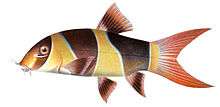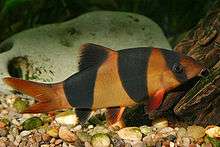Clown loach
| Clown loach | |
|---|---|
 | |
| Scientific classification | |
| Kingdom: | Animalia |
| Phylum: | Chordata |
| Class: | Actinopterygii |
| Order: | Cypriniformes |
| Family: | Botiidae[2] |
| Genus: | Chromobotia Kottelat, 2004 |
| Species: | C. macracanthus |
| Binomial name | |
| Chromobotia macracanthus (Bleeker, 1852) | |
| Synonyms | |
|
Botia macracantha | |
The clown loach (also tiger botia),[3] Chromobotia macracanthus, is a tropical freshwater fish belonging to the botiid loach family. It is the sole member of the Chromobotia genus. It originates in inland waters in Indonesia on the islands of Sumatra and Borneo. It is a popular fish in the freshwater aquarium trade and is sold worldwide.[1]
Taxonomy and naming
The fish was first described as Cobitis macracanthus by Pieter Bleeker in 1852. In 1989, its scientific name was changed to Botia macracanthus.[4] In 2004, Dr. Maurice Kottelat divided the Botia genus, containing 47 different species, into seven separate genera, resulting in the clown loach being placed in a genus of its own, Chromobotia.[5]
The genus Chromobotia derives its name from the Greek word chromo, meaning "colour", and the regional Asian word botia, meaning "warrior" or "soldier"; the specific epithet Macracanthus is derived from the Greek word macros, meaning "large" and the Latin word acanthus, meaning "thorny", referring to the large spine below each of the fish's eyes. The common name, "clown loach" comes from the fish's bright colors and stripes (many tropical fish with stripes that stand out are commonly called "clown") as well as from its habit of 'entertaining' aquarium owners with strange habits, such as swimming upside down, or 'playing dead.'
Description and behavior

Information about the maximum size of the clown loach varies, with some estimates ranging up to 40–50 cm (16–20 in), and with typical adult sizes ranging from 15–20 cm (5.9–7.9 in).[6] The fish's body is long and laterally compressed, with an arched dorsal surface and a flat ventral surface. Its head is relatively large and its mouth faces downward with thick, fleshy lips, and four pairs of barbels. The barbels on the lower jaw are small and difficult to see. Clown loaches can make clicking sounds when they are happy, being territorial (used as a type of weapon/warning) or mating. This sound is produced by the grinding of their pharyngeal teeth.
The body is whitish-orange to reddish-orange, with three thick, black, triangular, vertical bands. The anterior band runs from the top of the head and through the eye, the medial band lies between the head and the dorsal fin, and wraps around to the ventral surface, and the posterior band covers almost all of the caudal peduncle and extends to the anal fin. There is some regional color variation within the species; the pelvic fins on fish from Borneo are reddish orange and black, while the pelvic fins on fish from Sumatra are entirely reddish orange.[7]
The fish is sexually dimorphic, with females being slightly plumper than males. In addition, the tips of the tail on the male curve inwards slightly, whereas the females have straight tips.[4]
The fish has a movable spine that lies in a groove below the eye, which may be extended as a defense mechanism. The spine may cause a painful wound, but is not venomous. It also may be used as a predation tool as it is set close to the mouth.
Distribution and habitat
Clown loaches are native to the islands of Sumatra and Borneo in Indonesia. Clear stream environments provide the optimal habitat for clown loaches, but biannual monsoon flooding forces the fish to move into flooded flood plains, or murky or blackwater rivers or lakes, for 7–8 months of the year, and clown loaches are commonly found in the flood plains of hilly areas.[3] Breeding adults migrate to smaller waterways to spawn annually.[6]
In its native habitat, the fish is found in water with a temperature range of 25 to 30 °C (77 to 86 °F), a pH between 5.0 and 8.0, and water hardness between 5 and 12 dH.[1]
In the aquarium

A common and popular fish for tropical freshwater aquaria, C. macracanthus is a visually pleasing species. Although specimens in the wild will reach 40 to 50 cm, in the aquaria it is uncommon for C. macracanthus to attain more than 15 to 20 cm fork length.
These fish have bifurcated spines under the eyes. They are thought to be used as a defense mechanism and possibly, for obtaining prey.
C. macracanthus will associate with other benthic species in the aquaria if kept singly or with few other specimens. They make suitable tank-mates for any non-aggressive community fishes, but do not thrive when kept with larger, more dominant species.
Occasionally C. macracanthus will exhibit erratic swimming patterns, such as swimming on their sides or upside down. This is not usually a cause for concern however, and the fish will normally return to normal behaviour almost instantly.
As C. macracanthus is found in riverine environments it is able to cope with good flow rates of water in the aquaria. Aquascapes should replicate this environment to suit the requirements of the species with areas of high flow, but also areas of low flow to allow the fish to rest. C. macracanthus is also fond of cover and is not overly accustomed to bright lighting. The fish will often seek areas of shade or cover in which to rest during the day and become more active when light levels are more subdued. Substrate in the aquaria should not be too large or coarse as the fishes barbules can become worn and damaged through foraging for food.
Clown loaches are particularly susceptible to Ichthyophthirius (ich),or white spot disease. Due to having small or no scales at all, a reduced dosage may be required when using certain types of medication, possibly reducing the effectiveness.
Most clown loaches accept commercial flake food and sinking pellets as their dietary staple, but thrive with a variety of food: live (worms, brine shrimp, small snails), banana, other plant matter, freeze-dried (tubifex worms, especially if it is fortified) and frozen brine shrimp (always thaw frozen food to aquarium temperature).
See also
| Wikimedia Commons has media related to Botia macracanthus. |
Videos and external links
- Video of clown loaches
- Care information for the clown loach at the Aquarium Wiki
- Chromobotia macracanthus
- Clown Loaches Community - Clown loaches Facebook page
- Clown Loaches Group - Clown loaches Facebook group
References
- 1 2 3 Froese, Rainer and Pauly, Daniel, eds. (2016). "Chromobotia macracanthus" in FishBase. January 2016 version.
- ↑ Kottelat, M. (2012): Conspectus cobitidum: an inventory of the loaches of the world (Teleostei: Cypriniformes: Cobitoidei). Archived February 11, 2013, at the Wayback Machine. The Raffles Bulletin of Zoology, Suppl. No. 26: 1-199.
- 1 2 "Clown loach profile". Badman's Tropical Fish. Retrieved 2007-08-18.
- 1 2 "Clown Loach". WetPetz.com. 2004. Retrieved 2007-08-17.
- ↑ Kottelat, Maurice (2004). "Botia kubotai, a new species of loach (Teleostei: Cobitidae) from the Ataran River basin (Myanmar), with comments on botiine nomenclature and diagnosis of a new genus" (PDF - abstract only). Zootaxa. 401: 1–18. ISSN 1175-5334. Retrieved 2007-08-17.
- 1 2 Åhlander, Ola (2 September 2004). "Clown loach Chromobotia macracanthus (Bleeker 1852)". www.bollmoraakvarieklubb.org. Retrieved 2007-08-18.
- ↑ Thoene, Martin (13 August 2007). "Clown Loach Coloration & Marking Variations". Loaches online. Retrieved 2007-08-18.